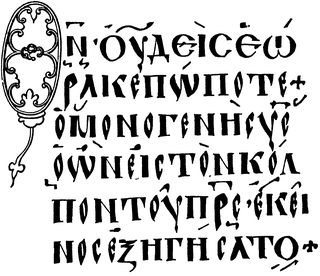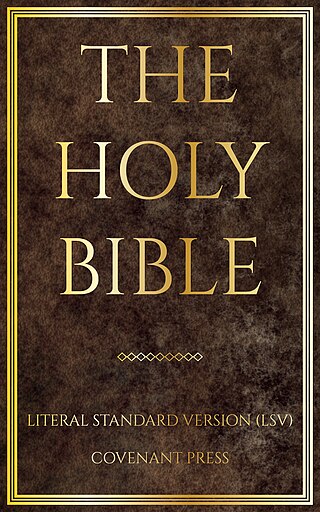The word aeon, also spelled eon, originally meant "life", "vital force" or "being", "generation" or "a period of time", though it tended to be translated as "age" in the sense of "ages", "forever", "timeless" or "for eternity". It is a Latin transliteration from the ancient Greek word ὁ αἰών, from the archaic αἰϝών meaning "century". In Greek, it literally refers to the timespan of one hundred years. A cognate Latin word aevum or aeuum for "age" is present in words such as longevity and mediaeval.
Partial Bible translations into languages of the English people can be traced back to the late 7th century, including translations into Old and Middle English. More than 100 complete translations into English have been produced. A number of translations have been prepared of parts of the Bible, some deliberately limited to certain books and some projects that have been abandoned before the planned completion.

The Douay–Rheims Bible, also known as the Douay–Rheims Version, Rheims–Douai Bible or Douai Bible, and abbreviated as D–R, DRB, and DRV, is a translation of the Bible from the Latin Vulgate into English made by members of the English College, Douai, in the service of the Catholic Church. The New Testament portion was published in Reims, France, in 1582, in one volume with extensive commentary and notes. The Old Testament portion was published in two volumes twenty-seven years later in 1609 and 1610 by the University of Douai. The first volume, covering Genesis to Job, was published in 1609; the second, covering the Book of Psalms to 2 Maccabees plus the three apocryphal books of the Vulgate appendix following the Old Testament, was published in 1610. Marginal notes took up the bulk of the volumes and offered insights on issues of translation, and on the Hebrew and Greek source texts of the Vulgate.

The New American Standard Bible is a translation of the Bible in contemporary English. Published by the Lockman Foundation, the complete NASB was released in 1971. A new revisions were published in 1995 and 2020. The NASB relies on recently published critical editions of the original Hebrew, Aramaic, and Greek texts. It is known for preferring a literal translation style that generally preserves the structure of the original language when possible, rather than an idiomatic style that attempts to match natural English usage.
The Genesis creation narrative is the creation myth of both Judaism and Christianity. The narrative is made up of two stories, roughly equivalent to the first two chapters of the Book of Genesis. In the first, Elohim creates the heavens and the Earth in six days, then rests on, blesses, and sanctifies the seventh. In the second story God creates Adam, the first man, from dust and places him in the Garden of Eden. There he is given dominion over the animals. Eve, the first woman, is created from Adam's rib as his companion.
The Julia Evelina Smith Parker Translation is considered the first complete translation of the Bible into English by a woman. As of 2017, she is still the only woman to have translated the entire Bible unaided. The Bible was titled The Holy Bible: Containing the Old and New Testaments; Translated Literally from the Original Tongues, and was published in 1876.
The Darby Bible refers to the Bible as translated from Hebrew and Greek by John Nelson Darby.
Green's Literal Translation or the Literal Translation of the Holy Bible (LITV) is a translation of the Bible by Jay P. Green, Sr., first published in 1985. The LITV takes a literal, formal equivalence approach to translation. The Masoretic Text is used as the Hebrew basis for the Old Testament, and the Textus Receptus is used as the Greek basis for the New Testament. This translation is available in book form and is freely available online for use with the e-Sword software program. Some also refer to it as the "KJ3" or "KJV3".

Matthew 7:21 is the twenty-first verse of the seventh chapter of the Gospel of Matthew in the New Testament and is part of the Sermon on the Mount. This verse continues Jesus' warning against false prophets.

In Christian theology, Hell is the place or state into which, by God's definitive judgment, unrepentant sinners pass in the general judgment, or, as some Christians believe, immediately after death. Its character is inferred from teaching in the biblical texts, some of which, interpreted literally, have given rise to the popular idea of Hell. Theologians today generally see Hell as the logical consequence of rejecting union with God and with God's justice and mercy.

John 1:1 is the first verse in the opening chapter of the Gospel of John in the New Testament of the Christian Bible. The traditional and majority translation of this verse reads:
In the beginning was the Word, and the Word was with God, and the Word was God.
Messianic Bible translations are translations, or editions of translations, in English of the Christian Bible, some of which are widely used in the Messianic Judaism and Hebrew Roots communities.
Ego eimi "I am", "I exist", is the first person singular present active indicative of the verb "to be" in ancient Greek. The use of this phrase in some of the uses found in the Gospel of John is considered to have theological significance by many Christians.
The phrase "unto the ages of ages" expresses either the idea of eternity, or an indeterminate number of aeons. The phrase is a translation of the original Koine Greek phrase εἰς τοὺς αἰῶνας τῶν αἰώνων, which occurs in the original Greek texts of the Christian New Testament. In the Latin Vulgate, the same phrase is translated as in saecula saeculorum.

Psalm 58 is the 58th psalm of the Book of Psalms, beginning in English in the King James Version: "Do ye indeed speak righteousness, O congregation?". In the slightly different numbering system of the Greek Septuagint version of the Bible and the Latin Vulgate, this psalm is Psalm 57. In Latin, it is known as Si vere utique.

John 1:18 is the eighteenth verse in the first chapter of the Gospel of John in the New Testament of the Christian Bible.

Revelation 17 is the seventeenth chapter of the Book of Revelation or the Apocalypse to John in the New Testament of the Christian Bible. The book is traditionally attributed to John the Apostle, but the precise identity of the author remains a point of academic debate. This chapter describes the judgment of the Whore of Babylon.

Ezekiel 34 is the thirty-fourth chapter of the Book of Ezekiel in the Hebrew Bible or the Old Testament of the Christian Bible. This book contains the prophecies attributed to the prophet/priest Ezekiel, and is one of the Books of the Prophets. In this chapter, Ezekiel prophesies against the "irresponsible shepherds" of Israel and states that God will instead seek out God's sheep and become their "true shepherd". The Jerusalem Bible notes the continuity of this theme, occurring in Jeremiah 23:1–6, here in Ezekiel, and later resumed in Zechariah 11:4–17, as well as in the New Testament.

The Literal Standard Version (LSV) is a Modern English translation of the Bible with a number of distinctive features. It describes itself as the most literal translation of the Bible into the modern English language. The first edition was published on February 2, 2020.

John 1:3 is the third verse in the first chapter of the Gospel of John in the New Testament of the Christian Bible.












